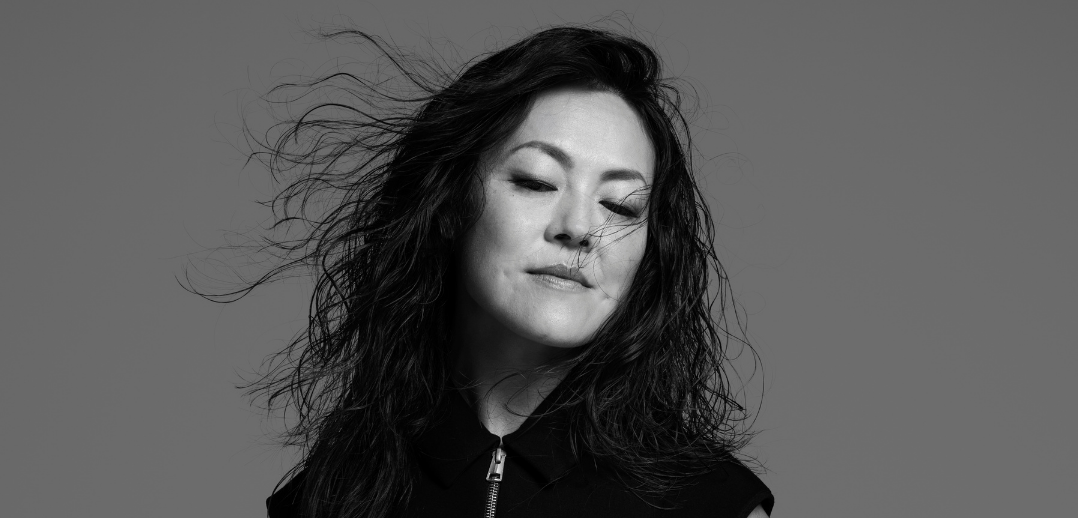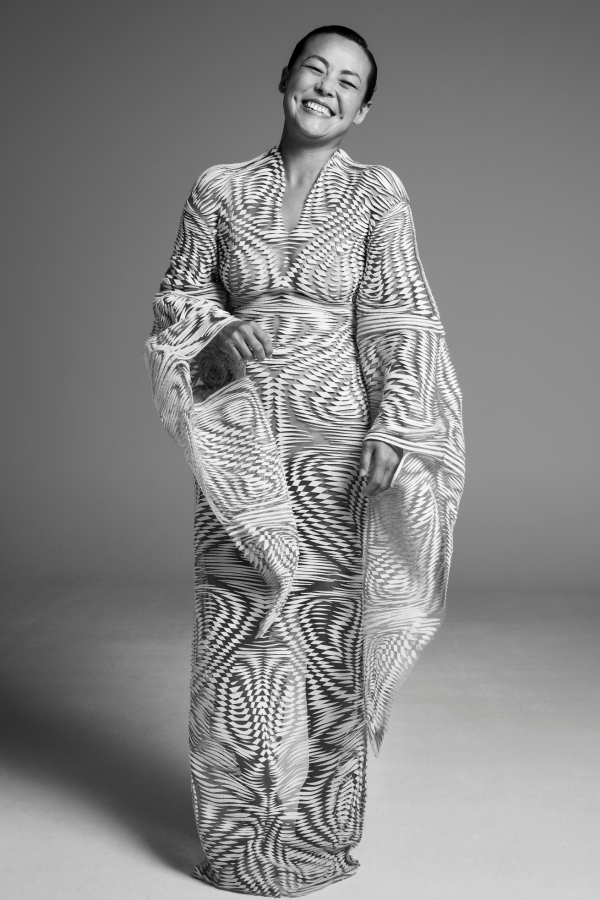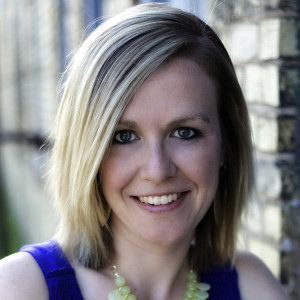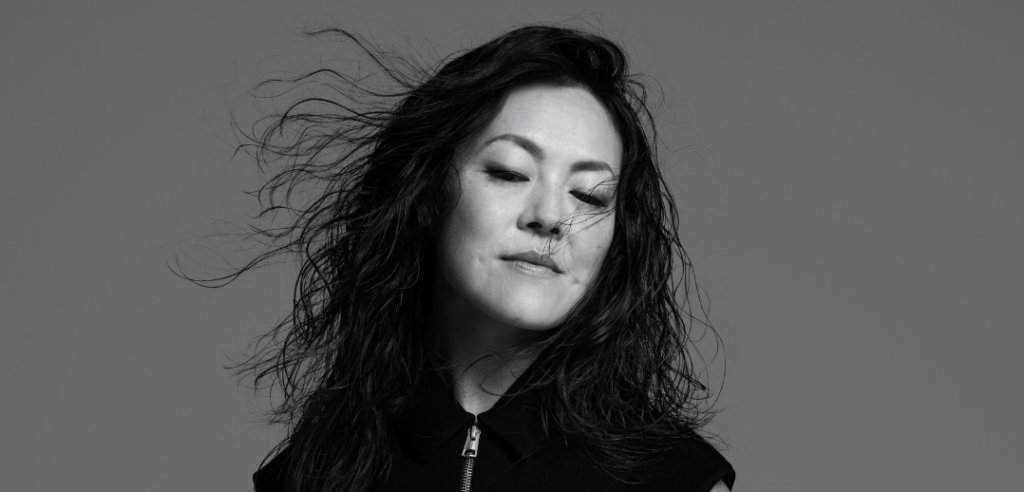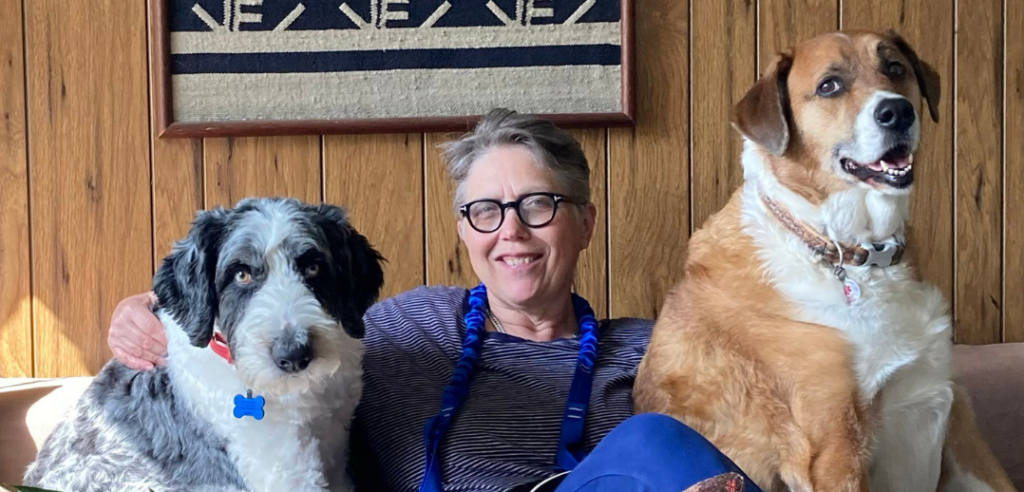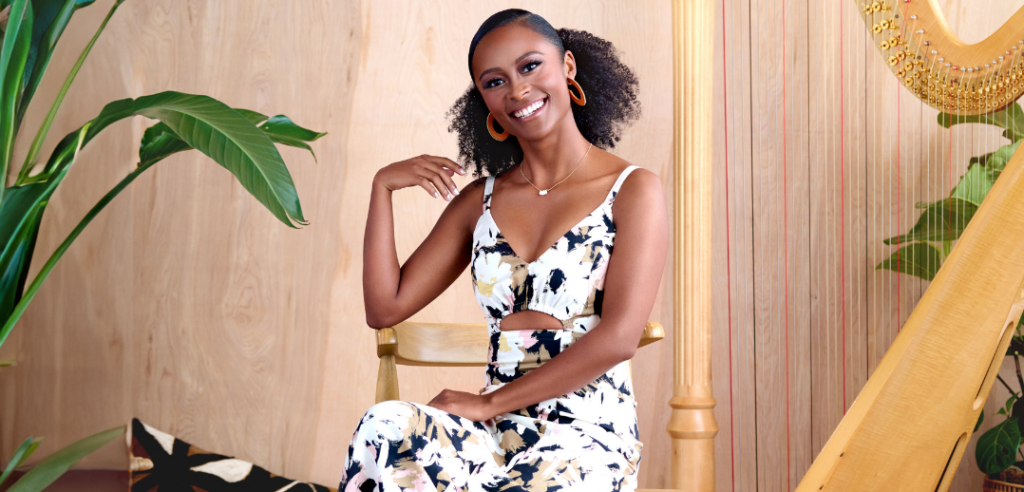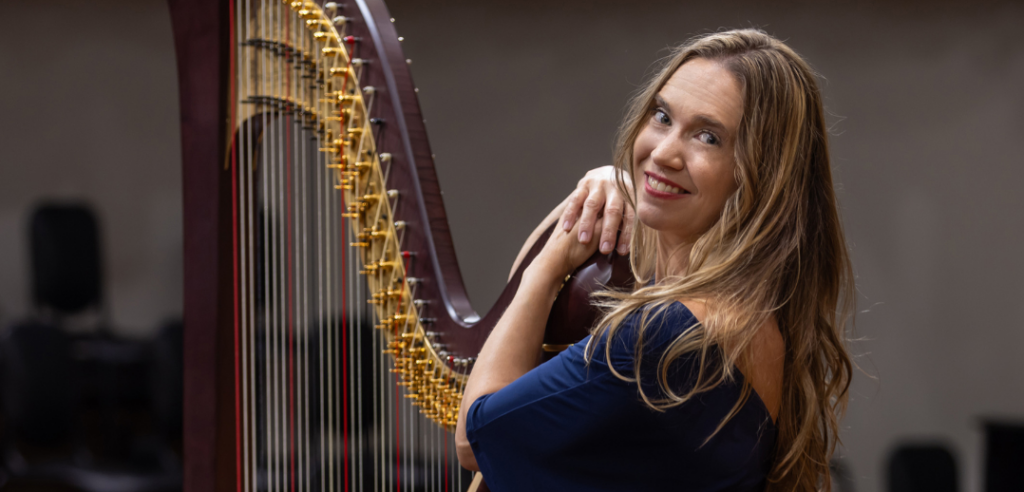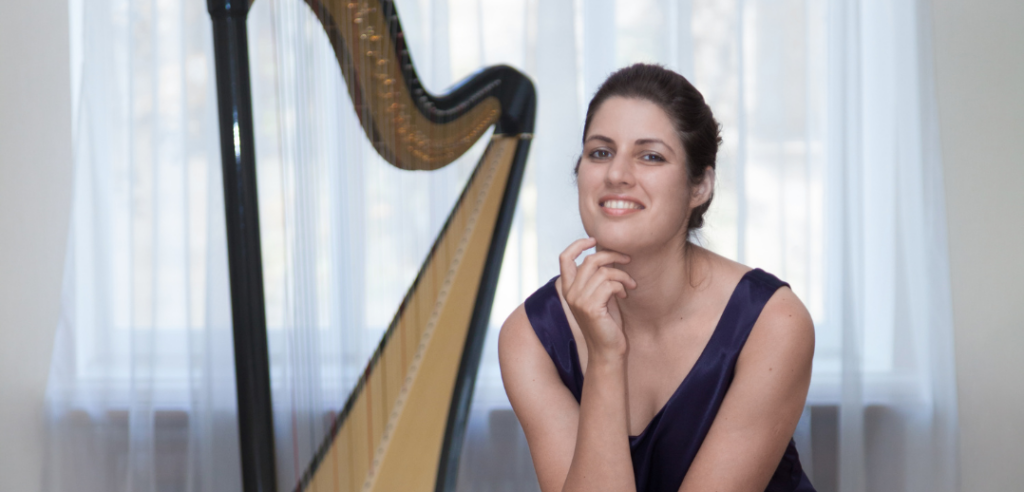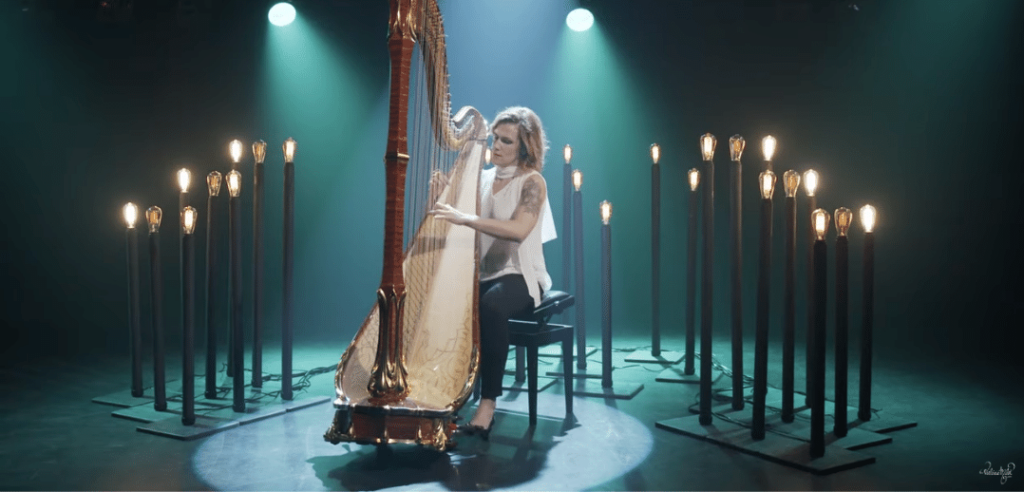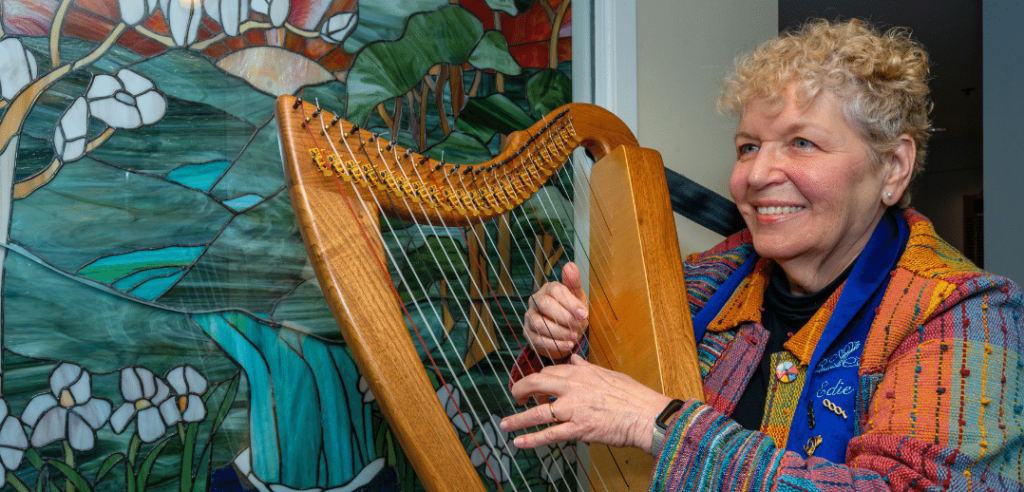I think in failing, you get to know yourself a lot better. It’s good to know what you don’t want and to be honest when something doesn’t work. This helps you to find your own voice in the music.
There aren’t many harpists in the world on major record labels. There aren’t many harpists who play music by Philip Glass or Ólafur Arnalds or Bryce Dessner. There aren’t many classically trained musicians who land on the rock music charts for three consecutive albums. There aren’t many, but there is one: Lavinia Meijer. The Sony Classical recording artist has been making a name for herself across musical and artistic borders since her days as a student at the conservatories in Utrecht and Amsterdam.
It was her 2012 album Metamorphosis, The Hours that made the mainstream music world take notice. The album, which features works by acclaimed American composer Philip Glass, arranged for harp by Meijer with the composer’s blessing, was a huge hit in the Netherlands and abroad, receiving a certified platinum disc.
Meijer was in the U.S. in January, promoting her latest album, Winter. We caught up with her on a cold, gray afternoon, befitting of her new album title.
Harp Column: Tell us about your new album, Winter, and how the idea for it came about.
Lavinia Meijer: I think, well, it’s a combination of two thoughts. The first is becoming more aware of the climate change around us and how it affects the seasons. Second, winter is the season of the year that feels closest to me, maybe because I was born in wintertime. I’ve already played pieces that reminded me of the season. When I play the music of Icelandic composer Ólafur Arnalds, I see the Icelandic winter landscapes in front of me. I also put on this album one of my own compositions that I composed during the winter, Open Window. I wrote it when we were locked down in the Netherlands, and we weren’t able to go abroad. For me, music was my way to travel. If we cannot travel physically, we can travel through music. So I made this piece with three movements, of which the second movement brings us to my country of birth, Korea. I didn’t have a clear thought of where the first and third movements would bring us, but I think that’s the beauty of music—you can make your own associations with it. So I had this piece that was written in the winter, and then I thought about the seasons, and I thought, why not make a whole year of projects since the seasons return in a cycle. I started this in the winter, and I’m working my way through one year of seasons, which works well in this age of digital music releases. I started with two winter singles then four in spring, four in summer, four in fall, and then a whole winter album to finish the cycle.
HC: In listening to the music you’ve released on these recordings so far, it is remarkable how evocative it is of the seasons, which is a really fabulous concept. You started out classically trained, and a lot of the recordings you made early in your career were focused more on classical rep, but your music choices have evolved into much more contemporary artists—Philip Glass, Ólafur Arnalds, Radiohead—and now you’re composing your own music. Tell us about this evolution.
The harp is part of music; music is part of art; art is part of culture and society in the world. It’s all connected.
LM: If I look at my development, I started playing contemporary music from a young age. I had the luck of being admitted to the young talent class of Erika Waarrdenburg when I was 11 years old. I had studied with her for just over 10 years [by the time] I finished with my master’s. She introduced me to contemporary music at a young age and told me at a certain point that I had the feel for contemporary music. There was definitely some [contemporary music] I didn’t like, but there were some really interesting pieces in which I knew that there is a story inside them and I wanted to find it. So it became my personal challenge to find the story in very complex music. My master’s exam was a combination of transcribing parts of The Well-Tempered Clavier by Bach, but also a program of the last 30 years of compositions. Even at that time, I knew I was interested in all of these things. Throughout the years my album visions have embodied that part of me with [compositions by] Paul Patterson, Garrett Byrnes, Tōru Takemitsu. When I had the opportunity to meet Philip Glass, my view on contemporary music changed or widened. It is something I learned about for maybe five minutes in my conservatory classes, but I actually didn’t know anything about what started to be called “minimalist” music, though Philip Glass is not happy with that term at all. What is contemporary music? It is music that is written in a certain time period by everybody, and everybody is so diverse, their influences are such a mixture, which I think is beautiful. For me, Philip Glass is an artist who uses his music to the fullest potential—he connects it to the world—to theater, dance, opera, film, science, society, politics. He is a very great inspiration to me when I think about wanting to promote the harp more as a solo instrument. The harp is part of music; music is part of art; art is part of culture and society in the world. It’s all connected.
HC: I want to talk a little bit more about Philip Glass and that relationship. How did you make the connection with him and his music?
LM: We have mutual friends—a well-respected music critic. He heard Philip Glass back in the ’70s in New York before his big breakthrough. Back then his music was not very well appreciated, often not being seen as music at all. Philip Glass was working in a museum and saw the contemporary art on the wall and thought, “What is the music that fits this art?” He started creating what he saw, and I think that’s a great inspiration, because the arts help each other move forward. So this mutual friend asked me, “Would you want to perform this music? Maybe he can write something for you?” At the time I didn’t know much about Philip Glass, but I knew he was huge, so I thought, no way. He had heard my name a few times, and when he came to Amsterdam to perform, he wanted to meet me and he asked me to play on his concert. Of course, I was very honored and happy, but at the same time, I had no idea what he wanted me to play. So I asked him, and he asked me to look at his Metamorphosis to see if I could transcribe it. So I did. On the day of the concert, we met, and it was actually a little bit of an audition moment because he asked me to play it. He was very focused in listening, and when I was finished, he said, “You know, I’ve heard this piece hundreds of times in different ways and on different instruments, but hearing it played by you and your harp gives me new insight into my own music.” That moment was very memorable because it showed me that he was someone who didn’t put himself above someone else. He looks at you as equal and the inspiration goes both ways, from artist to artist. From that point on, a friendship grew with mutual respect for one another. I also challenged him to write for the harp. At first he said, “No, I cannot write for the harp, it’s so difficult. You are the harpist, you know the harp—you can arrange anything you want of mine.” But then he started writing for me for different projects, so it kind of evolved, which is great.
So he invited me to perform in different projects and also introduced me to other artists. It was a great opportunity to play with amazing artists from very different fields. I think the further your fields of expertise are, the more respect you have for one another, because you are so aware that you are out of your element. So it makes you very nimble and very open to learning.
HC: Turning back to your recording career for a moment, you’re a Sony Classical recording artist, which is quite remarkable for a harpist. How did this come about?
LM: It’s fascinating to me how experiencing the life of an artist is about constantly moving yourself to a different position or looking at yourself from a different perspective, of which live performance is one, recording is one, and you have all kinds of other sub-parts going on. It’s a diverse and exciting way of living. When I released my Metamorphosis, The Hours album with my previous label, Channel Classics, it became a huge hit and brought the interest of more than one big record company. I chose to continue with Sony because I had a very good feeling about them. Not to say that my years with Channel Classics were not amazing, because they make fantastic recordings. But I think I was ready for the next step in my life.
It’s fascinating to me how experiencing the life of an artist is about constantly moving yourself to a different position or looking at yourself from a different perspective… It’s a diverse and exciting way of living.
I have to say that recording remains one big search for me. There are so many ways to record, and I am trying to find the best of the best. But as long as I keep moving in the right direction, I’m happy. I also want to challenge myself to stay open to all kinds of different approaches. For instance, in my last album, I think we used about 20 different microphones all over the harp and near it.
HC: How involved are you in the production side of your recordings?
LM: I am very involved, but I also want to give the sound technician their space. Of course you collect information and knowledge about a process, but there are so many things that you don’t know as well as someone else. So it’s always an exciting collaboration, because I learn from what other people come up with.
HC: You’ve built a very successful performing and recording career on the harp, which is no easy feat. Is there anything you can point to in your training that you would credit with helping you achieve the career you have?
LM: I think that if you call it success, it comes with many different factors. When I hear a student at the conservatory, I hear a person with a lot of talent, but it’s not a guarantee for success. I’ve always believed that success is a result of a mixture of factors. I had the luck of having a very good teacher from a young age who guided me in the best possible way. I put in a lot of hours practicing. I was asked once how many hours I have practiced before I was 20 years old, and I calculated it was about 17,000 hours. When I entered the Young Talents class at the conservatory at age 11, my teacher told me that if I wanted to be better, then I had to practice more than just a half hour before I came to class. So I started practicing. I started doing competitions when I was 13, and that really helped me focus on perfecting my playing, but I was also very much in that Young Talents bubble. I was this cute girl who could play well, and everything was fantastic. So there is a certain focus and discipline. But there was also a big passion inside me growing. I think that passion started to come out when I was about 15 years old without me really knowing what was happening. I got a call from a concert programmer who asked me if I could play on their series, but they wanted me to bring a violinist or a flutist because they said the harp by itself is boring. That was a turning point for me. I stayed on the phone with him for half an hour convincing him that he only had to program me. Finally he said I could come by myself. After the concert he came to me and said, “I take back everything I said. I wasn’t bored for one second.” That was certainly a victory for me. So it became a personal mission for me to show a side of the harp that the audience might not be familiar with. Slowly I began to get more interviews, and I figured out that I don’t have to sound like a professor when I’m talking about the harp. I can assume that there are no harpists in the room when I am playing, so I need to speak to people who don’t know the instrument. So I started reshaping my talks, and that’s when the media picked me up more and more. I got invited to the biggest TV show in the Netherlands in which all the artists that perform only get one minute to play. I cannot show what I want to show in one minute, so I asked if I could do a compilation of four different styles on the harp. I did Baroque, Romantic, atonal, and jazz. It made a huge impact because the music crossed over from classical to other areas. The harp has experienced challenges to evolve ever since music became more chromatic way back when. So my way of bringing it up to the 21st century is to ask composers to write for the harp.
HC: You’ve done a lot of different music not written for harp—have you ever tried something that just didn’t work?
LM: Definitely. It’s so interesting because the only things we hear and see are the things that work. But coming back to your previous question about advice, I would say you have to embrace failure. I think if you want to grow, you have to be able to deal with disappointments and failures, and I’ve had quite a lot. You have to keep trying. Sometimes I just assume I will fail nine times and then the tenth time I will succeed.
HC: That’s a good message for everyone to hear, that failure is part of the process.
LM: I think in failing, you get to know yourself a lot better. It’s good to know what you don’t want and to be honest when something doesn’t work. This helps you to find your own voice in the music. What I’ve found in deciding what music to arrange, if I have the feeling that the composer could have also written the piece originally for the harp, then it’s a go.
HC: Is there music, a type of music that you wish more harpists would play?
LM: It’s not specifically music, but with every instrument, there are techniques that are being taught and there are different schools that aim for certain techniques, and sometimes I feel [those techniques] are being followed too strictly. If you are shaping your own sound, you need to try things and work until you get the sound that you are looking for, rather than starting with the technique. The technique is always supporting the sound. A harpist said to me recently, “When I see you play, I see everything that my teacher forbids me to do.” [Laughs] Well, that was exaggerated, but I thought it was funny.
HC: Do you think that there’s something to the saying “you have to learn all the rules before you can break them?” Especially with classically trained musicians, you’ve learned all these techniques, you’ve built this foundation, now…
LM: …let it all go. Maybe that’s something that I’ve started doing more and more over the years.
HC: Right—embrace the freedom that comes with learning all the rules. Interesting. Who would you say have been the biggest musical influences in your life?
LM: Certainly Erika Waardenburg for educating me. If you look at her students, they’re all very different, and I like that. They’re not copies of her. She was almost like a second mother to me and has given me a lot of great advice. Also, Hans Heg, who came into my life just before I graduated and became sort of a mentor and coach to me, besides also being a very good, dear friend. He was a retired classical music critic for one of the biggest newspapers, and he had a very good network. He supported me, and he introduced me and connected me to a lot of people in the music world. This gave me a lot of confidence, and that’s what I needed after I graduated, because that’s the moment where you break loose from your safe haven and you’re on your own and wondering what is next. He also encouraged me to audition for the biggest music prize in the Netherlands, which I thought no, that’s not for me. But then I did it and I got the prize. Meeting Philip Glass also was a very important moment. He became a very important person in my life. He confirmed that I want to be an artist that has music as the center of my life. Seeing how Philip Glass lived, with music connected to everything in his life, I thought, yes, this is what I admire.
HC: What do you like about playing the harp?
LM: When I think back to when I first heard the harp, it was the closest to the human voice, for me. The sound feels like a womb, it feels like a very safe place. I like that I can put emotions in it that I cannot express in other ways. It always goes parallel to my life. So when I needed to be confident, I could do that through the harp. Whether it’s sadness, anger, happiness, joy—it’s all there. I feel enriched having the harp in my life. I also like that it’s a unique instrument. Wherever you go, there’s always someone in the audience who’s never seen the harp that close before. It’s always unique. It’s special.
HC: What is next for you? Once your new album is released, what projects would you like to pursue?
LM: I hope I continue to record, but it’s also just one part of my life. What I really like doing is making different programs, whether it’s just a solo evening of harp and talking about the music or it’s more of a theatrical approach or collaborations with other artists. One of my solo shows, I called “My Life Work,” is something I started a couple of years ago. It’s a more theatrical show because it also involves video and audio, like spoken text. I hope to make a performance every two years. In each performance I explore the question, In 100 years from now, how will we look back on this time? What will we call it? We have modernism, postmodernism, what comes after postmodernism? So, it’s more like a philosophical theme, and it allows me to connect music to different arts, asking different artists what they think. So with their input and what I’ve experienced in those two years, I make this performance. So in March, the third edition of “UNTITLED 3” will happen. And then later this year, I’ll be performing a tour with great puppeteer Duda Paiva And I’m also working on an autobiography right now, so there are a lot of different things happening. •
Learn more about Lavinia
Last album or artist that you listened to? Sufjan Stevens.
Favorite place in the world that you visited? It would have to be New York or Seoul.
If you could do anything else for a living, what would it be? This is difficult because it makes me ask myself what am I as passionate about as I am about music? There’s nothing that I can think of, but my career is also a lot about managing myself. Maybe I would do something in managing because it involves being organized, but also is very creative.
Piece of music that you always come back to because it feels like home? Metamorphosis 2 by Philip Glass or a Korean folksong called “Arirang,” which takes me back to my Korean roots.
Guilty pleasure? Karaoke.
Heels or flats? Heels. When I started playing the harp, I couldn’t reach the furthest pedals without wearing heels.






